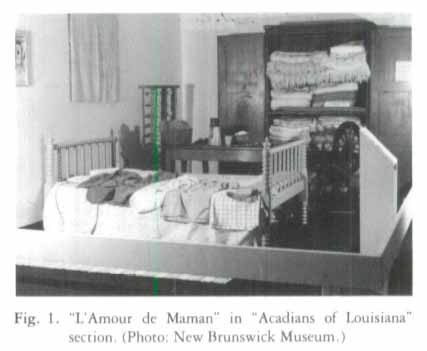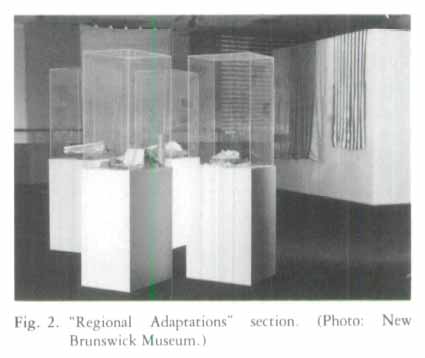Reviews / Compte Rendus
Louisiana State Museum, "L'Amour de Maman: Acadian Textile Heritage"
1 The exhibition, "L'Amour de Maman: The Acadian Textile Heritage," was one of the better travelling displays shown in recent years at the New Brunswick Museum. Although this exhibition's showing at the New Brunswick Museum (late October 1984 until January 3, 1985) was considered a success in most respects, "L'Amour de Maman" was not entirely blemish-free.
2 Produced by the Louisiana State Museum, "L'Amour de Maman" examines the production of textiles by the Acadians who arrived in Louisiana during the second half of the eighteenth century. While the focus is on Louisiana Acadian textiles, and the tools and techniques employed to make them, the exhibition also reveals elements of a way of life. As the catalogue states, "both textile production and textile use became associated with social customs integral to the Acadian identity. " Forced to adapt to a new climate and new materials in Louisiana, the Acadians developed a textile tradition that continued until the middle of this century. "L'Amour de Maman" documents two hundred years of Louisiana Acadian textile production and Acadian customs that are no longer practised.
3 Careful thought led to the selection of the exhibition's main title, which stresses the connection between a lifestyle and the textiles produced by that Acadian society. An Acadian mother spent a tremendous amount of time spinning and weaving a trousseau of utilitarian textiles for each of her daughters. This custom, known as L'Amour de Maman (mother's love), represents one of the traditions connected with Acadian hand-woven textiles and provides an appropriate title for the show.
4 The display was subdivided into four main sections; each dealt with a particular aspect of the exhibition theme. The first section, "Acadians of Louisiana," outlined the origins of the Acadians and their settlement in that state. The custom of L'Amour de Maman and the role of textiles in Acadian social life were clearly explained for the museum visitor. "Regional Adaptations" emphasized that the Acadians applied traditional weaving patterns and techniques (which had been used to produce wool and linen textiles in northern climates) to cotton fibre available in Louisiana. Both the growing and the processing of this "new" fibre were featured in this section. "Textures and Patterns," the third subdivision, described the wide-variety of woven patterns produced and how the weavers were able to make these variations. The exhibition's final section, "Acadian Women: The Artisans," was, for the most part, a tribute to the women who wove Louisiana Acadian textiles. This concluding section also informed the visitor that the production of traditional hand-woven textiles has ceased, for few Acadians continue to weave today.
5 Even though the New Brunswick Museum displayed "L'Amour de Maman" using the tour recommended subdivisions, the arrangement at the Museum was somewhat confusing. While the introductory and concluding sections were discernible, the placement of display units did not indicate a traffic pattern for the visitor to follow and the four different sections were not clearly separated. Several of the artifacts and photographs were not exhibited in their proper section, but these flaws did not detract from the display to any significant degree because the four sections were thematically very closely connected.
6 Several design defects did damage the visual effectiveness of the exhibition. The most disturbing was the crowding of the first section into an area that was too small. The most visually interesting display, which described the custom of "L'Amour de Maman," appeared to be squeezed into a corner (see fig. 1). There was sufficient room in the gallery to move the two large display boxes to more central positions, thus eliminating that problem. The uneven distribution of artifacts, and other exhibit materials, gave the impression that the rest of the display was somewhat barren. The majority of one wall was covered by a row of textiles, while the final wall had a number of photographs displayed as a group. Most of the visual boredom associated with these walls could have been eliminated by the placement of different types of artifacts within these groupings. Unfortunately, the plexiglass covers available for the exhibit cases went too tall for the artifacts they protected (see fig. 2). These cases would have appeared more suited for their task had the excessive height been reduced by using smaller covers Another flaw was present on the introduction panel produced at the New Brunswick Museum. Although this panel was not unattractive, a photocopy of the exhibition catalogue's cover was used. Had more thought been given to the display layout, most of the defects mentioned could have been corrected.
 Display large image of Figure 1
Display large image of Figure 1 Display large image of Figure 2
Display large image of Figure 27 Two types of information labels were present in L'Amour de Maman. Both the theme copy and object labels used enlarged print; this helped to prevent eye-strain. The theme labels were informative, concise and well written. Object labels were brief and clearly identified the artifacts for the museum visitor. Even though the labelling provided a wealth of information about the history, trail it ions and hand-woven textiles of the Louisiana Acadians, the amount of copy was not excessive. The label quality indicated that a great deal of time and effort had been expended by the exhibition organizers of the Louisiana State Museum.
8 The artifacts selected for this travelling exhibition also revealed a high level of scholarship. A careful selection of representative artifacts had been assembled from the collections of over thirty individuals and institutions in France and the United States. Over seventy textile items, including blankets, coverlets, sheets and some clothing, were displayed along with various tools of the weaver. Cotton fibre was provided to illustrate the different steps in the refinement process. When the appropriate samples of cotton were exhibited with the different tools, the visitor was able to understand many of the operations necessary to create hand-woven textiles, without having to read the attached labels. A number of period photographs showed Acadian women performing the various steps required. Since label copy had been kept to a minimum, the artifacts effectively illustrated the exhibition theme. The labels performed a supportive function, allowing the artifacts to be the dominant interpretive features in the show.
9 For the museum visitor who desired additional information, a bilingual catalogue was made available for the exhibition's international tour. This catalogue is a brief (95 pages), but comprehensive, treatment of the subject. Well written and illustrated with numerous black-and-white photographs, the catalogue provides the reader with information that could not be included on the exhibition labels. Three years prior to the opening of "L'Amour de Maman" in New Orleans in 1981, Vaughn Glasgow (chief curator of the Louisiana State Museum) and Tabitha Wilson Rossetter (guest curator) began their research. Both the catalogue and the exhibition benefitted from their efforts; the publication will serve as a lasting contribution to the study of Louisiana Acadian textiles.
10 Although the presentation of "L'Amour de Maman" at the New Brunswick Museum suffered slightly because of a poor layout, this travelling exhibition was one of the most informative displays to visit New Brunswick in recent years. It effectively transmitted its message that, "The Acadians of Louisiana developed a unique, long-lived and vigorous textile tradition." As an added bonus, the research performed to produce this exhibition has helped to preserve information about Acadian traditions and material culture. The assembled artifacts were permitted to speak for themselves (with the aid of informative labels) because the organizers at the Louisiana State Museum had not relied on fancy display techniques or an excessive amount of label copy. Based on scholarly research, the catalogue, labels and selection of artifacts for "L'Amour de Maman: The Acadian Textile Heritage" provided the museum visitor with an enjoyable educational experience.